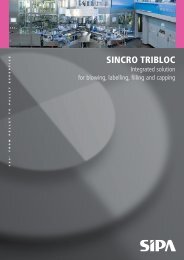C14_SIPA Magazine_issue4_2013_uk.pdf
C14_SIPA Magazine_issue4_2013_uk.pdf
C14_SIPA Magazine_issue4_2013_uk.pdf
You also want an ePaper? Increase the reach of your titles
YUMPU automatically turns print PDFs into web optimized ePapers that Google loves.
_64<br />
could only take place with the<br />
consent of the republic.<br />
Whoever was not registered could<br />
neither carry out any work in<br />
glassware, nor could they benefit<br />
from any of the other privileges<br />
granted to citizens of Murano.<br />
BeAutY, Art AnD<br />
technologY<br />
Today, the artisans of Murano<br />
still employ centuries-old techniques,<br />
crafting everything from<br />
contemporary art glass and glass<br />
jewellery to chandeliers and wine<br />
stoppers. The “glass master” is<br />
assisted by two aides called the<br />
server and serventino. They support<br />
the long metal rod that the<br />
sPecial - Just around siPa<br />
master blows through to give the<br />
desired shape to the glass.<br />
The two assistants also in turn manipulate<br />
the glass with the tools<br />
at their disposal, among which<br />
the spatula and a set of pliers<br />
called the borsella are considered<br />
essential. The ancient art of Murano<br />
glass production has many<br />
claims to fame, but the technique<br />
that probably made the island’s<br />
art unique is the blowing process<br />
that for centuries has made<br />
possible the creation of graceful<br />
and delicate objects such as cups,<br />
glasses, candlesticks and ornaments,<br />
all sought after as much<br />
today as they ever have been.<br />
The technique and skills of the<br />
Murano glassmakers have remained<br />
virtually unchanged<br />
over the centuries, and even today<br />
you can walk around the islands<br />
(which are so close together<br />
that they are connected by short<br />
bridges), admire the craftsmen<br />
at work, and have them tell tales<br />
about a manufacturing process<br />
full of beauty, art and technology.<br />
Blown glAss<br />
anybody watching a PeT preform<br />
being turned into a bottle<br />
can see where the process comes<br />
from. To make blown glass, the<br />
artisans blow the molten material<br />
into shape through a long cane,<br />
just as tradition dictates that,<br />
millennia ago, man familiarized<br />
himself with glass and all its<br />
amazing forms.<br />
This ancient technique, in the<br />
hands of experienced and skilled<br />
great master craftsmen, creates<br />
small masterpieces, each one<br />
unique and absolutely unreproducible.<br />
Watching the creation of a work<br />
of art from a simple glowing bubble<br />
is certainly an emotional experience,<br />
but even more incredible<br />
is the understanding of all<br />
the history and all the passion<br />
contained in that beautiful blown<br />
glass.<br />
Murrine<br />
The words Murano and murrine<br />
may look similar, and they are indeed<br />
both connected with glass,<br />
but they have their own histories.<br />
The term “murrine” was coined<br />
in the modern era in 1878 by abbot<br />
Vincenzo Zanetti, who contributed<br />
much to the revival of<br />
Murano glass after it had passed<br />
through a long period of crisis.<br />
Zanetti adopted this term to define<br />
glass mosaic vases and bowls<br />
that the romans made using sec-<br />
tions of glass cane that had inside<br />
them, for their entire length,<br />
abstract designs or faces, flowers<br />
and animals, which are revealed<br />
when cut in cross-section.<br />
The sections are fused together<br />
to form a surface, which is then<br />
shaped into the final object.<br />
during the Middle ages, the<br />
technique for the production of<br />
murrine glass disappeared, but<br />
the technique was taken up again<br />
towards the end of the nineteenth<br />
century at the salviati glassworks,<br />
by Vincenzo Moretti.<br />
The term murrine has remained<br />
since then, and is now used both<br />
to identify both the individual<br />
sections of the glass canes as well<br />
the object obtained from their<br />
composition.<br />
sPecial - Just around siPa<br />
_65
















